Content Marketing
Effective content marketing is the secret to attracting more qualified leads to your business. Great content builds relationships, authority and trust with your audience. In this ultimate guide we will share how to develop content that demonstrates thought-leadership and adds true value to engage your prospects.
TABLE OF CONTENTS
What is Content Marketing?
The Content Marketing Institute gives this definition:
“Content marketing is a strategic marketing approach focused on creating and distributing valuable, relevant, and consistent content to attract and retain a clearly defined audience — and, ultimately, to drive profitable customer action.”
Working in advanced engineering sectors, and with our B2B marketing focus, we define content marketing as:
“A means of demonstrating thought leadership (through the provision of advice and guidance) and making available all the information a buyer needs to make a confident purchase.”
The need for content marketing has been driven (demanded, even) by the market. Audiences are tuning out most forms of advertising and placing far greater trust in content and, by extension, those providing it. Those who provide the most valuable advice and guidance to help their existing customers and prospects – and without making any ‘hard sell’ when doing so – will build trust and be front-of-mind when products or services are needed.
Because of its predominantly online nature, content marketing is an essential aspect of any company’s digital marketing strategy. Also, it has different roles to play at each of the levels in your marketing and sales funnel.
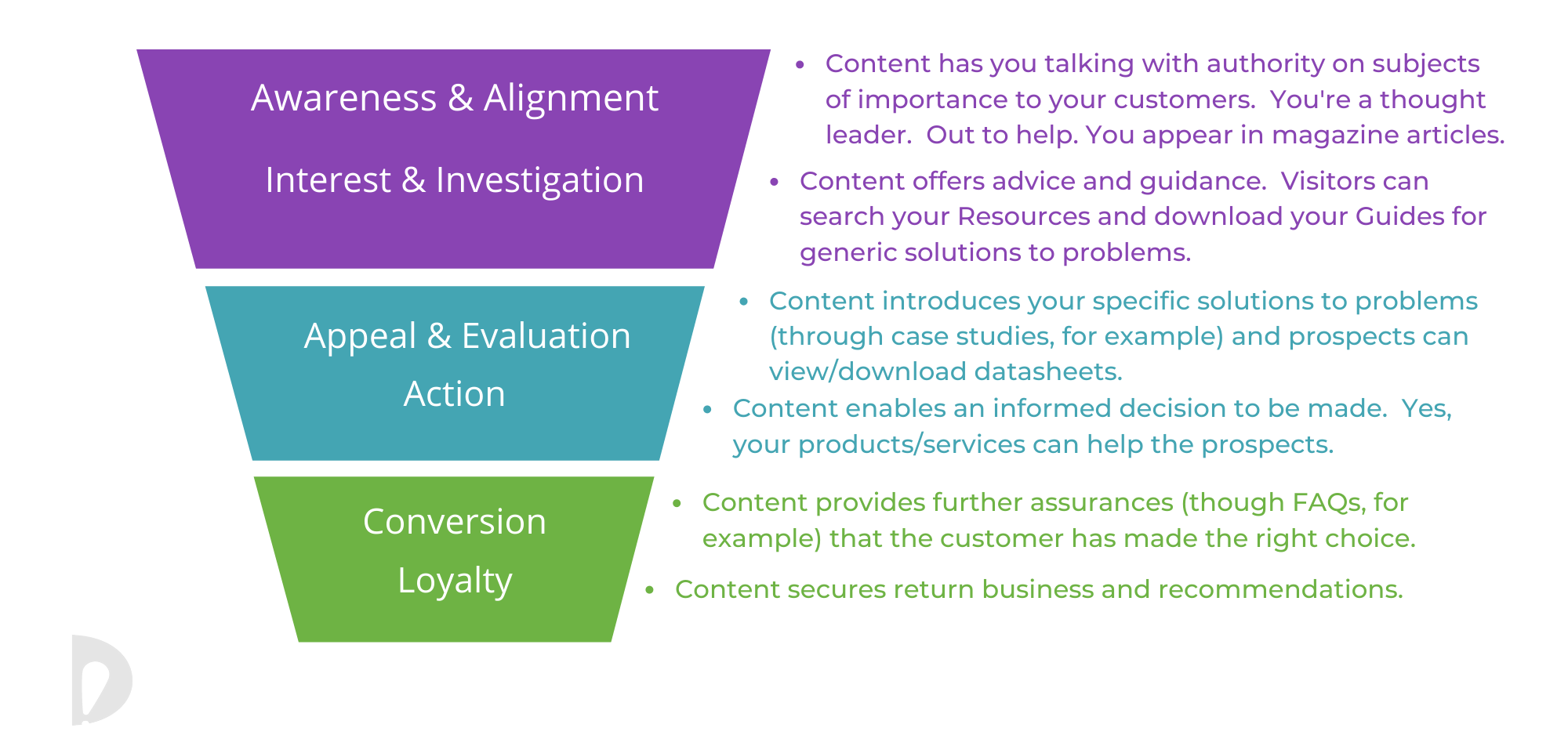
Content’s role is to support a buyer’s journey through the sales funnel
As per the above figure, your products and services are not introduced until the middle of the funnel. Even then, it is a gentle/subtle introduction.
All content in the top third of the funnel demonstrates your expertise and industry relevance. In B2B engineering sectors, you will be showing customers how to solve problems but will not (certainly within the top third of the funnel) be telling them which of your products or services they should use.
The use of advice-rich content at the mouth of the funnel is in sharp contrast to (and from a customer’s perspective, a most-welcome change from) the marketing strategies of yesteryear. They all led with: “This is who we are. This is what we do.”
Content marketing should be seen as an investment that attracts, qualifies and converts leads. Fortunately, the investment need not cost that much as all the expertise (your company’s industry know-how, for example) already resides within your organisation, otherwise you would not be in business.
The expertise within your company needs converting into content which, while not without its challenges, is worth the effort.
The Benefits of Content Marketing
You cannot grow your business without content. It is how you qualify and cultivate leads. Moreover, the provision of content that aligns with how buyers research and make purchasing decisions helps them.
In essence, content marketing makes it easier for:
- You to sell to the buyers you most want to do business with, and;
- Customers to buy from a seller they trust and respect.
The provision of content that aligns with how buyers research and make purchasing decisions helps prospects and existing customers alike.
In terms of ROI, content marketing outperforms advertising and paid searches. Not only are these mechanisms no longer producing the results they once did, but audiences are placing more trust in search results that do not carry an ‘Ad’ marker; and are scrolling down to search results that have earned their ranking. How did they ‘earn’ that ranking? Today’s search engine algorithms prioritise relevancy and quality. This means, from a digital marketing perspective, SEO and content are tightly linked. Prospects are increasingly starting to perceive ad-led results as a form of ‘ranking bribery’.
Another big benefit of content marketing is that it [the content] can do most of the lead generation and sales conversion work for you. For example, the more information that is available to enable prospects to make an informed decision before contacting your sales team will make their life easier. Similarly, if prospect’s ‘informed decision’ is that your products or services are not what they are looking for, then that is good too. There’s no point the prospect contacting your sales team and wasting their time.
Indeed, done properly content marketing can present your sales team with high-engagement-good-fit leads. Converting those leads is how your business will grow – in the direction you want and at the rate you want.

Useful, informative and emotive content can guide the kind of customers you most want to do business with to the point of sale – by which time they will be confident they have made the right decision. Whether the next step is to Proceed to Checkout (online) or contact your sales team to place an order, content has done the majority of the work.
Also, the availability (online and sent out in newsletters, for example) of fresh content (such as Top Tips and ‘did you know…’ posts) about your products will not only enable your customers to get the most from their purchases but it can also lighten the workload of your aftersales and technical support teams. In addition, it builds loyalty and gives customers further confidence that they will receive the same level of service with subsequent purchases.
On another note, digital content is really coming into its own as there are fewer opportunities to meet prospects face to face – a trend that was developing before (and was greatly accelerated by) COVID-19.
While there may be some return to how things were pre-COVID, content-powered digital marketing is here to stay, and those companies that do it well will reap the benefits.
Types of Content Marketing
Website Pages

Your website is arguably the most important place for several different types of content – such as articles, blogs, case studies, guides, white papers and videos – but you also need ‘glue content’ – to hold everything together. Your website’s content needs to support the buyer’s journey. It also needs to reflect your brand and convey quality.
Blog Posts

These are essential for lead generation and if you focus on ‘thought leadership’ you can really demonstrate your expertise on a specific topic. Also, blog posts are ideal ‘cluster content’ to place around a pillar page that addresses a broader theme. The use of keywords in a blog is crucial to ensure high rankings. Also, consider guest blogging on a partner’s site and ask them to guest on your site. You’ll both benefit.
Articles

Made available on your website, on social media platforms like LinkedIn and appearing in trade press publications, articles discuss hot topics in detail. The length will be between 800 and 2,000 words. However, ‘long-form’ articles (mainly for publication on your own site) can be between 10,000 and 20,000 words. These often rank high in search results because of their sheer volume; and you may have experienced this for specific technical terms, because academic papers (several pages long) tend to rank higher than shorter pieces.
Case Studies

Prospects value these highly because they recount how you have helped others. Do not scrimp on the level of detail though as a brief ‘We helped company X’ boast is of no value. A case study needs to be at least 2,000 words long and include photos of products in situ (not brochure images) and tangible results regarding the real benefit your products or service produced.
Guides

As with blogs, these are an essential form of content marketing. Guides have more long term value though. The writing style is considerably different from that of a blog. There should be far more original content, and you must be prepared to refresh the guides on a regular basis. Version numbers and publishing dates lets prospects and existing customers know you are on top of this.
Infographics

These are a popular and easy-to-digest way of conveying key facts and figures, or simply delivering a series of concise messages. They are easy to produce and are ideal for breaking up long web pages (such as blogs, articles and guides) even though they repeat [or rather distil] information written in long form. If they are not too large/complex they are ideal for posting on social media with a few words of explanation and linking back to the blog, article or pillar page in which the infographic is used.
White Papers

These are a form of report about a product, solution or technology. They should contain a wealth of technical content and should be more research based. On the plus side, most of the research will have already been done within your organisation. For example, if the white paper is about a new product you are bringing to market, you can recount the philosophy, thinking, research and risk mitigation behind the product design, prototyping, manufacture and test. Doing so delivers a clear message to prospects: Here is a well-conceived, well-designed and thoroughly tested product.
FAQs

Frequently asked questions are an effective means of conveying information already available (in product descriptions and data sheets, for example) online and available for download. FAQs can help address any concerns potential buyers may have. For example, “Question: does this product have a battery backup?” “Answer: No, but one is available as an accessory.” Such openness demonstrates you remain keen to meet all the prospect’s requirements. FAQs can also be used to provide information to customers post-sales, which can help reduce your technical support team’s workload.
eBooks

These require considerable effort as they will be longer than long-form articles. They are valued by prospects as they offer guidance, tips and provide useful background information. You need to put a lot of time and effort into producing an eBook, so don’t just give them out. They should be ‘gated content’, so ask for something in return. For example, anyone wishing to download the eBook should answer some questions or complete a form. The questions/form should not be off-putting though. Just general market research, to enhance your perception of the market and your buyer personas.
Social Media Posts

These are great for commenting with authority on things going on in your industry. If you include the most appropriate hashtags you stand to place yourself in front of new potential customers. Your competitors are playing the same game though so be sure to maintain your standards and remain true to your brand. Also, don’t forget to encourage discussion or to comment on posts others are making. That is what social media is all about.
Videos

These should be engaging – and should engage in different ways. For example, some videos can be well-produced, serious and informative. As with infographics, it is safe to repurpose long form text into a script. Other videos can be less formal and more amateurish (in look and feel) but still serve a purpose. Don’t go too basic though, and the use of a camera and boom mic is still recommended.
Checklists

These are an often-overlooked type of content needed to support a buyer’s journey. They are particularly useful towards the end of that journey, to provide assurances that the product they are about to buy will meet their requirements.
While each of the above types of content is different from the others, a common element is that they all have value. They all provide varying degrees of help, and they represent your brand.
It is advisable to group the most useful content in a Resource or Knowledge Base section on your website. Alongside your Products and Services top-menu options, a Resource or Knowledge Base section reflects how keen you are to help prospects and customers. See Content Marketing Tips.
Pillar Pages and Topic Clusters
These are relatively new devices which, as is the way with most digital marketing techniques, are all about being found and ranking high when prospects go searching.
A pillar page focuses on an overarching theme relevant to (say) one of the sectors/markets your company serves. The word ‘relevant’ is important here. For example, if your products are used by customers in the automotive sector, you would not have an Automotive pillar page. Instead, you would focus on a subject/issue with which your prospects might need advice, Vehicle Autonomy, for example.
The page need not necessarily hang directly off your menu bar. It could be under Resources, for example. The important thing is that it is a common landing page/place for various forms of content – such as blogs, video, guides, etc. – that are relevant to parts of that page.
Your pillar page will need an index and headers, which can be jumped to from that index. The headers are for sections of the page concerning a dedicated topic. Guides, blogs, articles, white papers on your website should link to the pillar page. This makes them ‘topic cluster’ (a.k.a. ‘content cluster’). You also need be sending out content through social media, for example, that focuses on individual topics/themes from your pillar page.

Above is a simplified view of how a pillar page should interact with other content on your site and the outside world. Arrows numbered (1) reflect how your resources (such as guides, articles, cases studies…) and your products and services pages link to your pillar page. But not the other way round. Google doesn’t like that!
The shaded arrow (2) reflects how extracts from your resources feed into outlets such as LinkedIn. Arrow number (3) reflects how some of the outlets will become traffic sources (if the outbound content does its job), and arrows numbered (4) reflect how traffic sources should be arriving on your pillar pages and your resources.
Not shown but paid sources can of course go to your products and services pages. Some organic searches might too if a prospect searches for something specific that only you offer. In reality, and when trying to attract new leads, prospects’ searches will be for a generic solution to a problem, and that is what your pillar pages and guides, must provide.
Arrow (5) is an important one, as your pillar page should include a few (but not many) links to authoritative sites. Google likes that.
A pillar page should contain at least 4,000 words; a considerable change from the advice given by site developers and SEO specialists only a few years ago, who said “keep pages short to avoid scrolling.”
At the top of the page, close to the index, you should have an ‘explainer video’ (about 3 minutes long).
You should be able to read a pillar page top to bottom. You should also be able to dip in for a specific topic as that is how prospects are likely to come in; from a video you have put on YouTube or an Infographic you may have shared thorough LinkedIn, for example.
It is recommended that you include a few calls to action (CTAs) on your pillar page, but they should be for the provision of further support or information – as we have done above, for example – and not links to your products or services. Remember, the prospect is most likely only just entering your sales funnel, so do not rush in with any hard sell. You are still advising, guiding and helping. And if a prospect wants to view your products or services they can do that provided you have not made navigation complex AND the rest of your content supports their journey.
Lastly, the bulk of the pillar page content should be reproduced in a professional looking downloadable guide. This gives prospects three options: Read the page, watch a short video (for just the headlines) or download the guide.
The Challenges of Content Marketing
Content marketing need not cost a fortune. It does though require an on-going commitment (of resources and time) if you are to produce consistent quality and keep pace with your customers’ changing needs and wider industry/market issues.
The commitment needs to come from the top, and there lies the first challenge. It can sometimes be difficult to secure management’s buy-in because content marketing is quite different from traditional marketing. It is part of a long-term strategy to build-trust and support customers. It is likely to be a slow burn.
Senior management is used to signing off on quick-fire campaigns, like Ad Words, because they produce a series of short-term measurable results. Ads can be re-run, refreshed or retargeted as required. However, the ROI is no longer as great as it once was.
Audiences are becoming desensitised. This is not to say all advertising activities should cease. Rather, you need to be aware, certainly in B2B, that audiences are becoming used to getting help, support, advice and guidance, for FREE, as and when they want it. That’s today’s marketplace. Any company not providing good content will be looked upon with suspicion.
Also, those working in marketing might find it difficult to embrace content marketing fully. As mentioned, it is necessary to reduce your reliance on advertising and other practices that worked well in the past. For instance, most marketers are in their comfort zones managing ad’ campaigns and the designers to produce material – all to fit what you wanted to tell the market. Now, the market is saying what it wants to hear. Content! And Google recognises that. Those providing the most useful content will rank highly in search results.

If you work in marketing, you may feel your role has evolved into one of Information Services. To a degree, it has, and you must deliver because you are competing for attention, and to be found when prospects go looking for help or general advice. You need to be recognised as a thought-leader and someone who can help.
All marketers embracing content marketing – and committed to getting results – will be busier than before. You should not underestimate the volume of content required or the effort needed to keep it fresh and compelling. Your campaign management skills still have immense value in this new form of marketing, but you are likely to be managing copywriters and content creation agencies more than advertising agencies now.
Indeed, the B2B marketing landscape has changed so much you can even outsource specific campaigns, which you still manage, in their entirety. Doing so reduces the risk of errors in your content (online and outbound) because another challenge is making sure mistakes – such as typos or grammatical errors – don’t slip through your proofreading processes.
Content marketing requires far more proofreading than (say) running an ad’ campaign. There’s more volume and, in high-tech B2B, the content must clearly be of a more technical nature, if you are to help your customers and prospects. Mistakes will have customers wondering where else quality control is lacking in your business.
Perhaps the greatest challenge you face with content marketing is to give prospects and existing customers alike a ‘positive experience’, but as long as you’re listening to the market and understand your buyers’ questions and preferences, that should not be too difficult.
Developing Your Content Marketing Strategy
A content marketing strategy simply identifies WHAT your different forms of content need to achieve. The HOW and WHEN is addressed later, in your content marketing planning; in which a good Content Calendar will certainly play a major role.
Formalise your strategy in a Word document (or PowerPoint presentation) because it must be shared with your colleagues in a familiar format. Neither the Word document nor the PowerPoint presentation need be large; two or three pages for the former, a dozen slides for the latter.
At a fundamental level, the strategy can be thought of as a list of objectives. “Our content must…”
- Build overall brand awareness
- Build long-term relationships
- Establish and maintain trust
- Educate, advise and guide
- Solve customers’ problems
- Better support Sales in securing business
- Reduce the need for Aftersales Support
As headers, they are unlikely to change over time. However, priorities will shift as a result of: a) your product launches and/or the introduction of new services, b) external events such as trade events and c) what your competitors are doing.
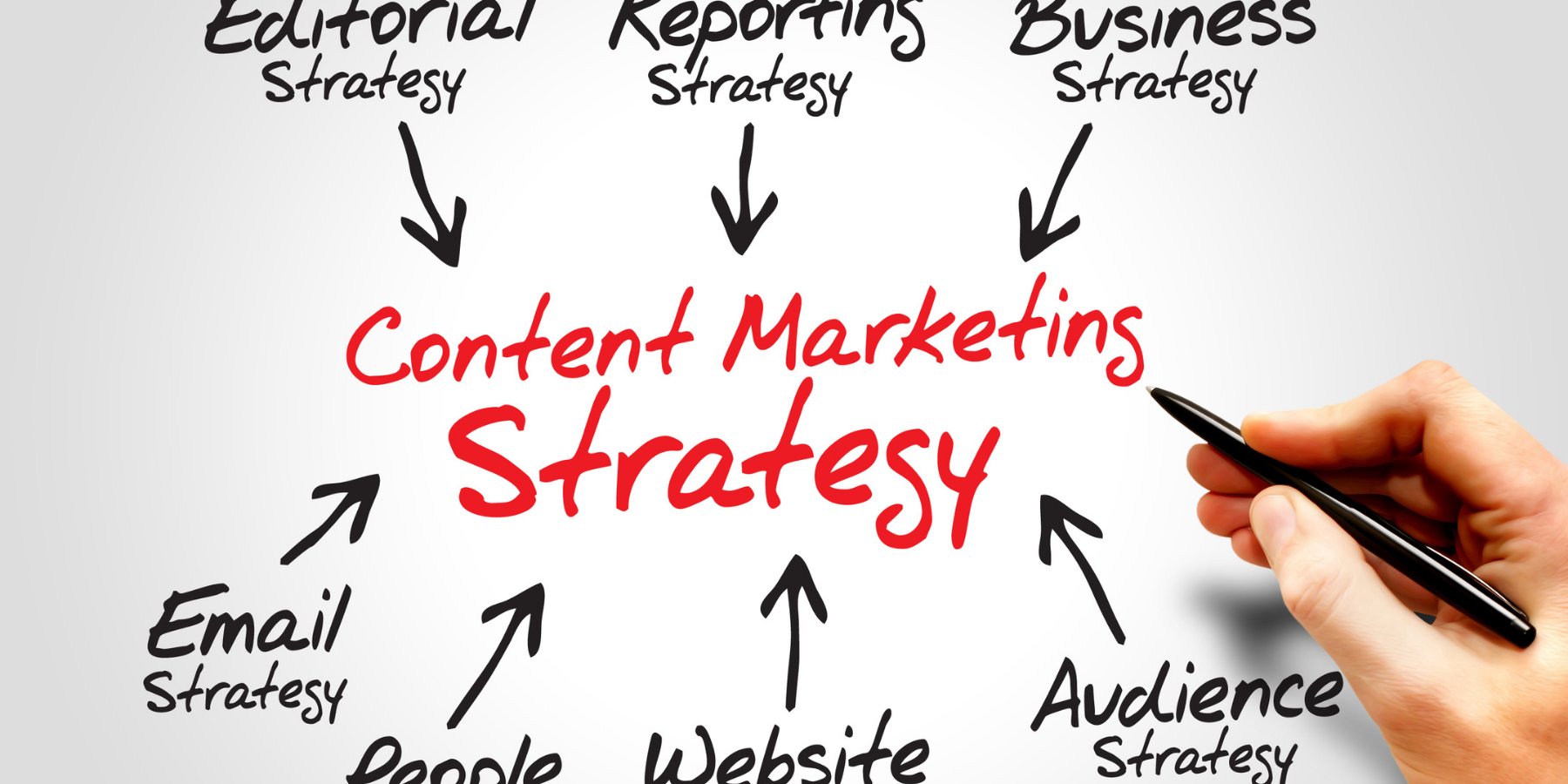
The strategy you develop must evolve. You need to be using the right content in the right way at the right time. As mentioned, at this level the HOW is not important.
Creating, managing and repurposing content will deliver the long-term results you need to grow your business; as mentioned, steady growth through trust, loyalty, referrals etc. Moreover, organic traffic will help grow your business provided the content ranks high in searches. Your strategy and plans (plural) for implementation will make that happen.
Creating a Content Calendar
To execute your content strategy, you will need a content calendar – one that can be shared with and easily understood by all stakeholders involved in the creation and repurposing of content as well as its use. Also, integration with (or the inclusion of) performance metrics can enable you to schedule the review and removal of content, i.e. your calendar need not just be about adding and refreshing content.
The first thing to appreciate is that different types of content have different lifecycles. A social media post has a short lifecycle whereas a video is much longer.
A basic content calendar can be built in Excel. For example, different forms of content can be tied in with specific campaigns (such as a product launch or exhibiting at a trade event) and given Go Live dates.
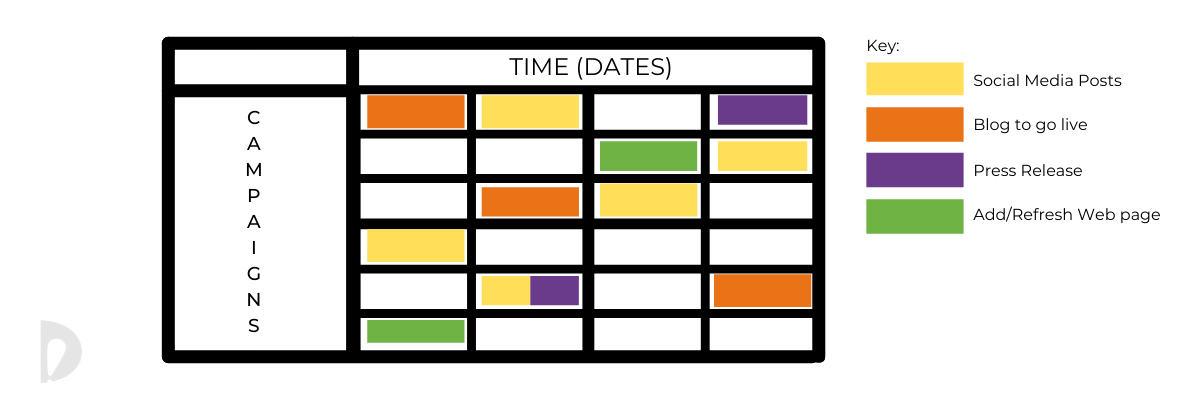
A better approach is to use a database, which can be thought of as multiple and interacting spreadsheets (tables). Data analysis is easier in a database and reports (produced from queries) are more meaningful because they can pull information from different tables.
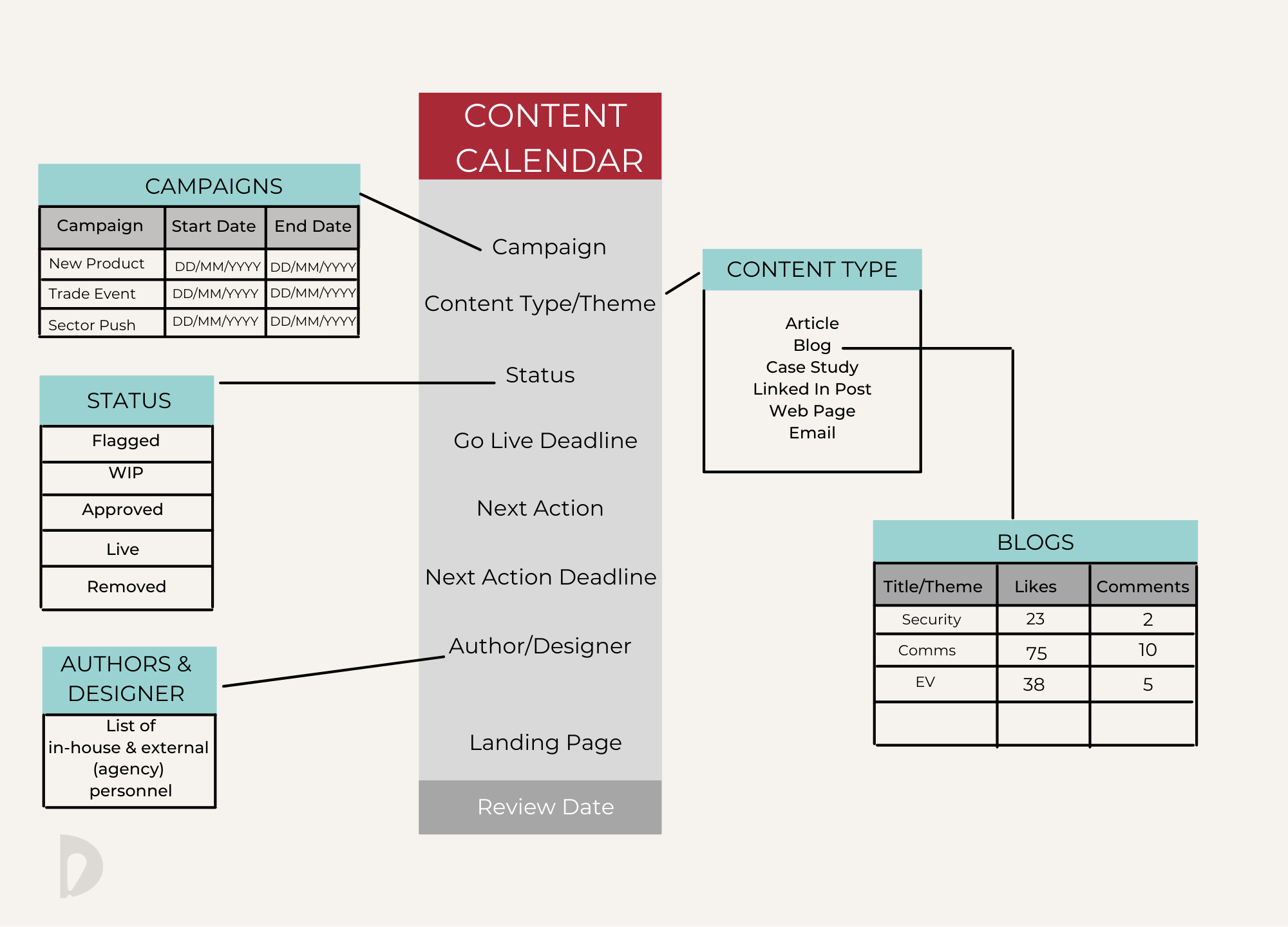
Above is an example of the relationships between tables in a database. The beauty of this approach is you can access the CONTENT PLANNER through any of the other tables, by way of quickly seeing:
- What content is planned, in progress and complete for a given campaign or trade event?
- Which content types are needed throughout the next few days, weeks and months?
- Where is the content coming from (who are the authors / designers and what are their deadlines)?
Not shown, but you would have separate tables for articles, case studies, LinkedIn posts, your webpages and email campaigns.
Your database can also include trade press editorial opportunities. This can be done by putting opportunities of interest (you’ll find these in the publications’ media packs or online) into a table that links to your Content Calendar.
Because most databases can export to Excel, it is easy to share information with all stakeholders. For example, you can issue production schedules for your content authors, graphics designers, video makers etc.
Crafted well, your Content Calendar can be used to record metrics – such as which press release resulted in coverage and where, how many likes/comments did a social media post receive. If you monitor the performance of all content, you can gauge which types (i.e. article, blog etc.) work best for which topic/theme, as you need to have such information at your fingertips to evolve your marketing strategy. Spreadsheets are too flat (2D) to cope with the complex relationships between all forms of content.
The Importance of Video Marketing
Your content is always competing for attention, and videos are the best way of getting noticed and securing engagement. They are far more attention-grabbing than still images and infographics, and they are ideal for mobile platforms.
Videos also allow you to put a face or faces to your brand, thus making your company more human. Though digital is everywhere (and crucial), we are still largely ‘sold’ on the idea of a product or service by humans; the advice they give, their behaviour and their professionalism on calls or in face-to-face meetings – all help the sales process. Buyers place their trust in people.
You will need a number of videos to guide buyers through your sales funnel and, of course, some videos to get them to the funnel in the first place.
While there are many different subject matters for videos, within the scope of ‘content marketing’ you should be looking to produce tutorials or tips on how to do things as top-of-funnel content. The focus should be on advice and guidance. For example, if you have products that comply with certain industry standards, consider making a brief video about (understanding) the standard. Middle-of-funnel videos can talk about your products and services but be sure to focus on end-user benefits and main features only.

Not all content is suitable for video. All the facts and figures, and technical specifications of your products belong in datasheets. The video’s role is to motivate the prospect to find out more.
You can also have, hero and behind-the-scenes videos in the middle of the funnel. They can help buyers decide whether or not they want to do business with you. For instance, if you are a distributor then the products you sell are likely to be available elsewhere (unless you have exclusivity), so you need videos that show how professional, friendly and dedicated you are as people. What’s the value you add that others don’t?
Bottom-of-funnel videos can be longer. They can be corporate videos, for example. It is also the place for longer product videos but stick with giving advice and guidance. How To videos are ideal in this respect. They can help assure the prospect that Yes, this is the product they want. And the detail in the video will help them use the product once they have it.
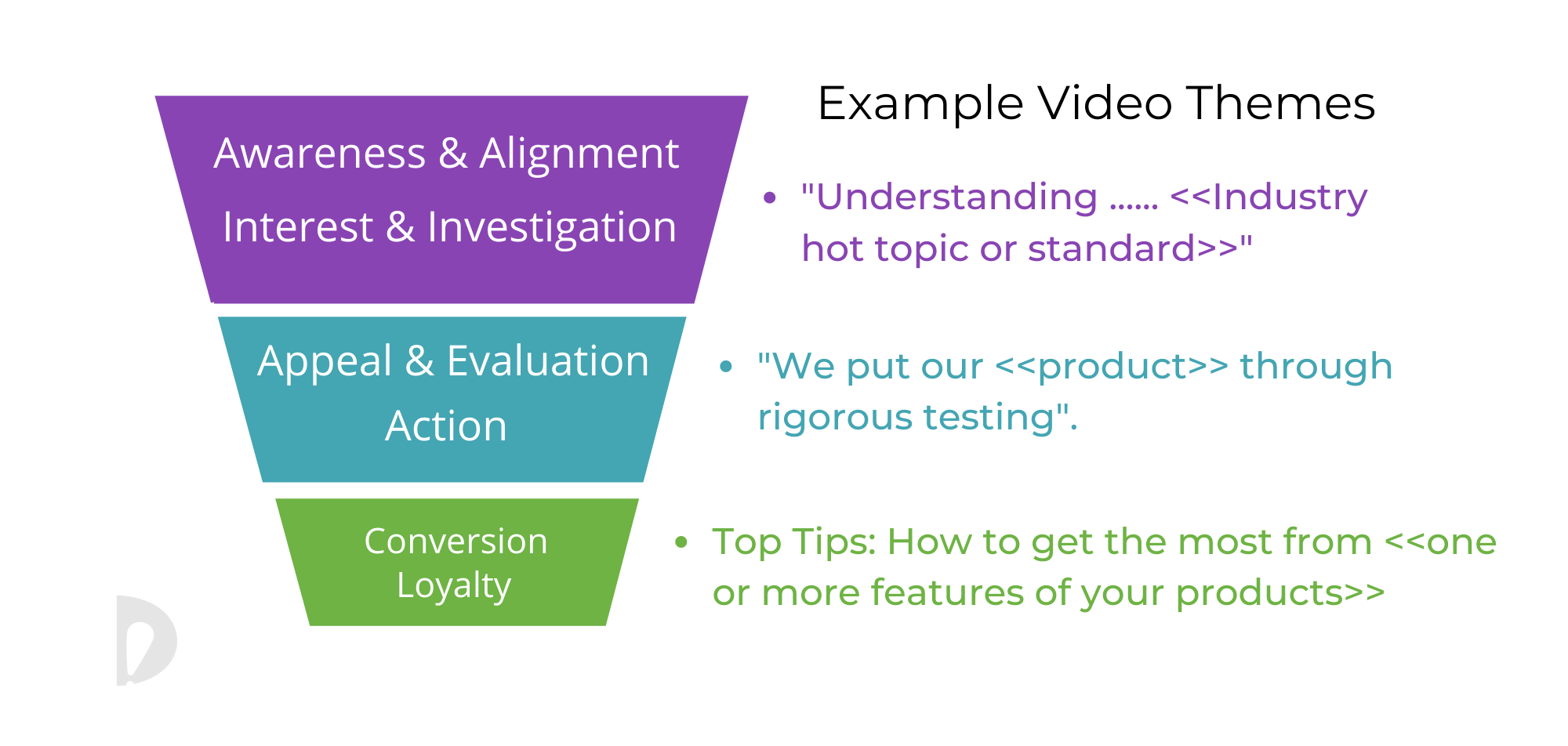
Having videos on your website will boost your traffic statistics as visitors will a) be on your pages for longer and b) more likely to visit your other pages. Most importantly, your search ranking will improve because Google considers videos ‘useful content’.
Even with sound muted (and so long as there is a text overlay), a short video can provide sufficient information to raise awareness, generate interest and make a call to action.
As for identifying the best subjects matters, they are best coming from the keyword research you are doing for all your other content – as part of your content marketing strategy – plus the metrics you are gathering for all your other content. For instance, your most read/liked/commented-on blogs, articles and guides will make great videos. You therefore need to include videos in your Content Mix and in your Content Calendar.
For the videos you post on platforms like LinkedIn and YouTube, be sure to use keywords in the names and descriptions of the videos. Even the filenames should contain keywords; a trick many marketers miss.
You must include links back to your site, ideally a pillar page, if a video is to do its job.
Explore and monitor the effectiveness of different styles of video. As mentioned, having people in your videos (perhaps demonstrating products) works well because it builds trust. Animations, be they of graphics, photos or a mix of both, work well too – particularly for delivering corporate messages.
In terms of lifecycles, most videos will be around for a long time so make sure the content will still have value in the future. For example, if you’ve just posted a video about your latest product, how will it [the video] look years from now (when the product has been superseded)? By thinking ahead, you can craft your video script such that your latest product (today) is part of a long-term roadmap and an ongoing commitment to serve evolving markets with fit-for-purpose solutions.
In terms of quality, for the best results you can of course engage a professional video production company – and this is worth considering for those videos that will have a long life; corporate videos for example. If you are making the videos yourself, be sure to invest in good equipment (camera, tripod, boom mic, lights etc.), as it will be difficult to convey the quality of your products and services with a video clearly taken on a mobile phone, for example.
Also, if you are going down the home-production route, make sure your scripts focus on end-user benefits and include advice and guidance.
Don’t wander into datasheet territory. Presenters should speak clearly and be presentable. And don’t forget the branding. Have the presenter wear a company shirt or have the company logo in the background.
Always provide your videos with a text overlay. The vast majority of short videos on social media are watched with the sound muted.
Lastly, as with any content, everything hinges on the opening. Irrespective of the length of the video, you have just a few seconds to capture the attention of (say) someone scrolling through pages and feeds on LinkedIn. Again, the text overlay is essential.
Content Marketing Metrics
These will include:
- Marketing and sales qualified leads (MQLs and SQLs) and conversion rates. MQLs are ultimately what marketers are paid to produce – i.e. leads that are likely to convert into sales. In terms of new business, SQLs can be thought of as subsets of the MQLs, i.e. what percentage of the leads found through marketing activities do the sales team see as converting. A high conversion rate is the main goal, and you can set the bar quite high provided the leads brought in through content marketing are good (i.e. focus on quality and not quantity).
- Your website traffic. What are your most visited pages? How long are visitors staying on these pages and which other pages do they visit? Which journeys are being taken through your site? What are the bounce rates? You must also monitor traffic sources and understand how prospects are reaching your site.
- Engagements through social media. While the number of likes and shares is a measure of the popularity of any given post, there is no substitute for comments; because that means people are engaging.
- Engagements through emails and e-newsletters. You need to monitor email opens and clicks. Also, keep track of Unsubscribes, as you need to understand why.
You also need to identify gaps in content. When you search for keywords, are you being found?
All metrics need to feed into your Content Strategy and, for the execution of that strategy, into your Content Calendar.

Content Marketing Tips
Have a good content mix. Some people may want to read what you have to say, others may prefer a video. Others may like infographics. In this respect, it is acceptable (advisable, even) to repurpose content.
For example, content for a pillar page may well start out life as a text-heavy Word document, but as it evolves its sections can be repurposed as infographics and videos.
Audit your content – or rather its effectiveness – using appropriate metrics. Remember, you are responding to what your market is asking for. However, for your website, the audit needs to be performed in the context of the journeys buyers are taking through your sales funnel.
Buyers engage with three to five pieces of content before engaging with a salesperson or purchasing online. It is therefore essential to support the buyer’s journey, and to do that you must understand your buyer. What will they be looking for? What type of content works best for them (written, video, infographic, etc)? Will they need to involve a colleague – with different concerns, priorities and preferences – in the decision-making process? Support their journeys too.
Still thinking in web terms, if a (landing) page is not getting many visitors BUT every visitor then goes to a page that has several visitors then there’s no harm in leaving it alone. Don’t make refreshing it a priority. Conversely, if none of the visitors progress their journeys you need to investigate why. Were there sufficient embedded links, or were they expected to use the menu bar?
As for pages that receive no visitors (consistently over a long period of time or during recent months), why is that?
Every now and then make a call to action (CTA) but it must be relevant to the theme and the medium. You should have at least one CTA on most of your website’s pages, in your blogs and in your guides. Also, making a CTA on social media can produce great results in the form of new leads and can do much to start the conversion process – provided the post itself still has value.
Regularly check that all links on your website function as intended as the removal of some pages may result in dead ends. Page Not Found sends out a bad message. As does Page Under Construction. There is no excuse for that these days, not when tools like Divi provide such great control.
Do not neglect existing customers. Remember, after ‘conversion’ comes ‘loyalty’ in the sales and marketing funnel.
Stick with familiar tools. There are dedicated planning tools available but have you the time to learn them? In your absence, could someone else use the tool? It is best to stick with Excel or, better still, Access (because it is easy to export to Excel).
As mentioned, case studies are very useful. They have value. But steer clear of just saying: “Company X had a problem and we solved it for them.” You need to consider multiple aspects (including commercial, time saved etc.) and quote at least two people from within your customer’s organisation. No more than 20% of the case study should be about your product or service.
Where online content is concerned, you can’t just post and forget. Your Content Calendar needs to include the refreshing and, if the metrics tell you, removal of content that has been live for a long time but had no views.
Repurpose content. Present the same messages in multiple ways. Provide choice. As mentioned, videos are very powerful marketing tools – and you’ll find tips in the Video Marketing section of this guide.
Lastly, do not neglect your existing customers. Indeed, from a content marketing perspective there’s an argument for putting them first; certainly the ones that are easiest to work with and provide a highest income for you, as presumably you are after more business like that. Produce content that will be of use to them but make it available to the broader marketplace.
Knowing when to get expert help with your content
Producing content can be challenging. This is particularly so in advanced engineering sectors. It is advisable to use an agency with a proven record of generating content in your sector(s). The acid test here is whether the agency can talk to you about marketing AND talk to your engineers on a variety of technical subjects.
